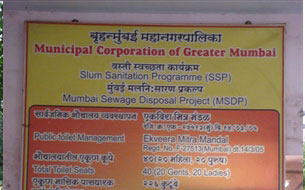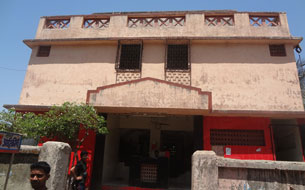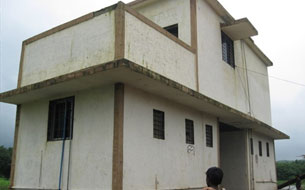Sanitation
The sanitation projects mostly include construction of subsidized community managed toilet blocks. The Alliance greatly acknowledges that the poor living in slums often upgrade their houses based on perceived security of tenure and access to finance. This applies as well to the construction of individual toilet seats attached to their homes. Financial support is provided in the form of loans to such families. The loan administration and recovery is organized and monitored by the federations.
Construction of community managed toilet blocks is now a part of the Slum Sanitation Program (SSP) of the Municipal Corporation of Greater Mumbai. With initial capital from World Bank, over 300 toilets were built across the city, each with a similar configuration, though the number of seats depended on the user strength. The program having understood the merits of having a community managed toilet block, introduced the formation of Community Based Organizations that are entrusted with the responsibility of undertaking the toilet maintenance. It now forms an essential part of the contract that is tendered out for the construction of the toilets and now forms an essential pre-requisite for beginning the construction. Toilets always need constant maintenance/ caretaking to insure the facilities are functioning to provide round the clock facilities to the settlement users since, in high density settlements the user traffic is much higher. Therefore this community toilet demonstrated constructing a caretaker’s place at the top of the toilet. This provides a safe dwelling space for the caretaker and his family and at the same time it insures constant care of the toilet at all times. A caretaker room is now an essential part of the construction.
Subsidized Community Toilet Blocks - 100% cost of toilet is provided by MCGM (Municipal Corporation of Greater Mumbai) for the MSDP program or by Mumbai Metropolitan Regional Development Authority (MMRDA) for the NMMR program. Cost of project construction and mobilization is placed as a bid during procurement. Loans for Individual Toilets - Collective Loan to MM groups that select households with a history of savings to disburse individual loans. SSNS/SPARC Revolving Funds are given as collective loan. 1% interest is charged per month.
Subsidized Community Toilet Blocks
SLUM SANITATION PROGRAM, PUNE In 1999, the Municipal Commissioner of Pune, Ratnakar Gaikwad, sought to greatly increase the provision and usability of public toilets by inviting NGOs to bid on toilet construction contracts. The new program planned to build 220 blocks during the period of 1999-2000 and another 220 during the period of 2000-2001. The contracts were not only for building toilets but also for their maintenance. In awarding contracts, priority was firstly given to settlements with more than 500 inhabitants and without toilet facilities; secondly, to areas where facilities were so dilapidated that they needed replacement. The design of the toilet blocks introduced several innovations. Unlike the previous models, they were bright and well ventilated, with better quality construction (which also made cleaning and maintenance easier). They had large storage tanks to ensure that there was enough water for users to use after defecation and to keep the toilets clean. Each toilet block had a separate entrance and facilities for men and women. A block of children’s toilets was included, in part because children always lose out to adults when there are queues for a toilet and in part because many young children are frightened to use conventional latrines.
The community toilets in Pune were so celebrated that officials and community representatives from other cities visited them to see how they had been implemented. The Mumbai Slum Sanitation Project is based on the Pune precedent.
Mumbai Sewage Disposal Project
BSDP was launched in 1995 by the World Bank and the Municipal Corporation of Greater Mumbai (MCGM) to expand the city’s sewage treatment plant and improve its sanitation infrastructure. In 1998, three NGOs were invited to undertake pilot projects to demonstrate how sanitation could be improved in the slums. SPARC constructed a community toilet block based on the designs it had implemented in Pune. The toilet had pour-flush latrines in equal numbers for men and women, specially designed children’s latrines, and a community hall and a caretaker’s room on the upper floors. The pilot project was a success and in 2001 the Slum Sanitation Project (SSP) was launched using this model. Under the SSP, more projects under MSDP have been taken up by the MCGM. SSNS was awarded a contract for 320 toilet blocks or 6400 seats in 16 administrative wards in the Mumbai but only 213 toilet blocks were constructed as there were political issues and other setbacks that the Alliance had to deal with. The success of MSDP 1 enabled SSNS to leverage municipal government funding to help improve city's sanitation infrastructure in the second and third phase under MDSP lot 8 and lot 9.
Nirmal Mumbai Metro Region Abhiyan
Government of Maharashtra took up the NMMR project in 2007, envisaging the construction of 1,00,000 public toilets across the Greater Mumbai Region in two years. The first phase of the project officially sanctioned the construction of 30,000 toilet seats in 14 Urban Local Bodies (ULBs). The model for these toilet blocks are similar to the ones constructed under MSDP. 289 out of a total work order of 363 were constructed under NMMR. Many sites had to be cancelled due to land ownership issues and political entanglements.
Loans for Individual Toilets
In urban areas unlike rural areas, most households in slums are less than 250 sq. feet. They have no linkage to the sewer system, don't get adequate running water. In such a situation, it is almost dangerous to have a toilet inside the house as faecal matter stays inside the house even if it gets flushed. Gradually, in smaller towns some of the households have begun to explore the possibility of creating a collective strategy to have individual toilets and put in pipes that take away the faecal matter in a tank where it gets treated. Like all savings and loans programs of Mahila Milan and NSDF, the strategy to provide loans for sanitation emerged from a need expressed by a particular community savings group; the terms were developed in discussion with their city federations and NSDF and Mahila Milan worked with SPARC and SSNS to develop a loan facility on terms agreed by them. So like all loans, these requests are also submitted to the Mahila Milan savings group and they are then given the loans after consultations locally.


